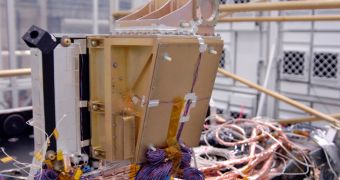An instrument on a NASA orbiter has recently provided that first detailed description of cosmic radiation patterns on and around the Moon. The data were collected using the Cosmic Ray Telescope for the Effects of Radiation (CRaTER) tool on the Lunar Reconnaissance Orbiter (LRO).
One of the challenges still associated with sending humans to Mars or other planets is the fact that any potential travelers would be battered by massive amounts of cosmic radiation on their way to their destination. This is where the conclusions of the new study may come in handy, experts say.
Details of the new research appear in a paper published in the November 18 issue of the journal Space Weather. For its measurements, CRaTER uses a tissue-equivalent plastic (TEP), a unique material that simulates how organic lifeforms such as ourselves may react to space radiation.
CRaTER determined that the Universe is permeated by forms of radiation other than that produced by cosmic rays. Some of these alternative sources are located relatively close to the surface of the Moon.
The Sun is also an important source of radiation, especially through solar winds and energetic particles that it releases during massive solar storms. The problem with these types of radiation is that they can occur unpredictably, and surge through a variety of materials without losing their energy.
The most significant threat is posed by ionizing radiation. This energetic light easily knocks electrons off of atoms, producing ions that are extremely reactive. The effects of such radiations on the human body are most likely very deadly.
“We've never had a detector that's been as good at understanding the effects of radiation through tissue-equivalent material as the CRaTER detector,” says University of New Hampshire professor Nathan Schwadron, who is the principal investigator of the CRaTER instrument.
“These publications document, wall-to-wall, different effects and instrument responses with some of the best long-term measurements ever made of radiation in deep space,” he goes on to add.
The new radiation characterizations CRaTER conducted will come in handy as researchers develop advanced types of materials to act as shields on future spacecraft heading for Mars or elsewhere.

 14 DAY TRIAL //
14 DAY TRIAL //